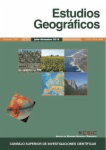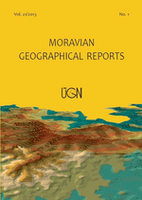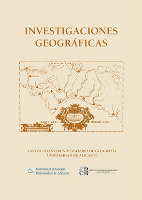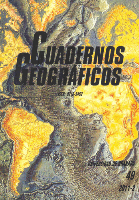
Estudios Geograficos
Scope & Guideline
Connecting Global Perspectives on Geography and Development
Introduction
Aims and Scopes
- Historical Geography and Cartography:
The journal emphasizes the importance of historical geography and cartography, exploring how historical land use patterns and cartographic practices shape contemporary understanding of geographic spaces. - Geospatial Analysis and GIS:
Research often employs geospatial analysis techniques and Geographic Information Systems (GIS) to analyze historical cadastral data, urban landscapes, and environmental changes. - Socio-Spatial Dynamics:
Estudios Geograficos investigates socio-spatial dynamics, including migration patterns, urbanization, and the socio-economic impacts of geographical changes in both historical and contemporary contexts. - Cultural and Environmental Heritage:
The journal contributes to the discourse on cultural and environmental heritage, examining how landscapes are valued, preserved, and transformed over time. - Interdisciplinary Approaches:
It promotes interdisciplinary approaches that incorporate insights from history, sociology, environmental science, and urban studies to provide a holistic view of geographical issues.
Trending and Emerging
- Geohistorical Sources and Cadastral Studies:
There is an increasing trend towards the use of geohistorical sources and cadastral studies, emphasizing the relevance of historical data in understanding contemporary geographical issues. - Impact of Climate Change:
Research addressing the impacts of climate change on urban environments and landscapes is gaining traction, reflecting a broader concern for sustainability and adaptation strategies. - Migration and Labor Dynamics:
The exploration of migration patterns, particularly in relation to labor dynamics during crises such as the COVID-19 pandemic, has become a significant focus, highlighting the interplay between geography and socio-economic conditions. - Cultural Landscape Valorization:
Emerging studies on the valorization of cultural landscapes reflect a growing interest in heritage conservation and the socio-political implications of landscape management. - Urban Resilience and Planning:
Themes surrounding urban resilience, particularly in the context of metropolitan environments and their adaptability to changing socio-economic conditions, are increasingly prominent.
Declining or Waning
- Contemporary Urban Issues:
There has been a noticeable decrease in research focusing on contemporary urban issues, such as urban crime and gentrification, which were more prominent in earlier publications. - Quantitative Economic Geography:
Studies specifically oriented towards quantitative economic geography, including detailed economic modeling, appear to be less frequent, indicating a shift towards qualitative analyses. - Traditional Agricultural Studies:
Research centered solely on traditional agricultural practices and their geographical implications has waned, with a noticeable shift towards more integrated approaches that consider broader socio-economic factors. - Historical Mapping Techniques:
The exploration of traditional historical mapping techniques has decreased as the journal increasingly prioritizes modern methodologies, such as GIS and digital cartography.
Similar Journals

Geoadria
Empowering Scholars with Cutting-Edge ResearchGeoadria, an esteemed Open Access journal published by the University of Zadar in Croatia, has been at the forefront of disseminating valuable research since its inception in 1996. With a keen focus on atmospheric science, demography, earth-surface processes, and geography, this journal serves as a crucial platform for researchers and professionals aiming to explore the intricate relationships between these fields. Although it currently holds a Q4 quartile ranking in various categories, such as Atmospheric Science and Geography, its commitment to promoting innovative scholarly dialogue ensures its relevance and utility within the academic community. Geoadria is indexed in Scopus, with rankings that reflect its ongoing contribution to the social sciences and earth sciences, notably garnering attention in niche areas. With a dedication to open access since 1996, the journal stands as a testament to the University of Zadar's commitment to enhancing global knowledge. Researchers, professionals, and students interested in geography, demography, and environmental sciences will find Geoadria a vital resource for the latest empirical studies and theoretical discussions.

Geo-Spatial Information Science
Exploring the Intersection of Geography and TechnologyGeo-Spatial Information Science, published by TAYLOR & FRANCIS LTD, is a premier open-access journal that has been at the forefront of disseminating cutting-edge research since its inception in 1998. With an ISSN of 1009-5020 and an E-ISSN of 1993-5153, this journal plays a pivotal role in the fields of Computers in Earth Sciences and Geography, Planning and Development, achieving a prestigious Q1 ranking in both categories as of 2023. Its exemplary Scopus rankings highlight its relevance within the social sciences and earth sciences, placing it among the top echelons of its field, with a 95th and 93rd percentile respectively. The journal aims to bridge the gap between innovative geospatial technologies and their applications in real-world scenarios, fostering interdisciplinary collaboration and advancing the global understanding of spatial data analysis. Based in the United Kingdom, Geo-Spatial Information Science invites researchers, professionals, and students to contribute and access research that shapes the future of geo-spatial sciences, all while adhering to open access principles that ensure broad dissemination and engagement with the broader academic community.

Moravian Geographical Reports
Fostering Collaboration in Earth and Environmental ResearchWelcome to the Moravian Geographical Reports, an esteemed Open Access journal published by SCIENDO, dedicated to advancing the fields of Earth and Planetary Sciences as well as Geography, Planning and Development. Established in 1993, this journal has steadily built a reputation for disseminating high-quality research, evidenced by its 2023 Q2 ranking in both relevant categories and an impressive Scopus percentile ranking of 72. With a dedicated editorial board and an expanding global readership, the Moravian Geographical Reports serves as a vital platform for researchers, professionals, and students alike, fostering dialogue and collaboration across various dimensions of geographical and environmental studies. Since its shift to Open Access in 2013, it has significantly enhanced the accessibility and reach of its published works, making crucial research findings available to a broader audience. The journal continues to thrive as a significant contributor to the geographical and earth sciences discourse during its converged years from 1993 to 2024.

Investigaciones Geograficas-Spain
Fostering collaboration in earth and planetary sciences.Investigaciones Geográficas-Spain is an esteemed academic journal published by the Universidad de Alicante, dedicated to advancing the fields of geography, planning, and development as well as earth and planetary sciences. With its commitment to open access since 1983, the journal ensures that research is readily available to a global audience, facilitating knowledge dissemination and collaborative discourse. As reflected in its 2023 Scopus rankings, it holds a commendable position within the Q3 category in both Earth and Planetary Sciences and Geography, Planning and Development, making it a noteworthy resource for scholars and practitioners in these disciplines. The journal's scope encompasses diverse geographical research, aiming to address pressing environmental and societal challenges through empirical studies and theoretical advancements. By contributing to the knowledge reservoir from Spain and beyond, Investigaciones Geográficas-Spain serves as a vital platform for researchers, professionals, and students seeking to enrich their understanding of geographical phenomena.

Geographica Pannonica
Unveiling Insights into Earth and SocietyGeographica Pannonica is a premier, open-access journal dedicated to the various dimensions of geography, atmospheric sciences, geology, and related fields. Published by the University of Novi Sad's Faculty of Natural Sciences and Mathematics, this Serbian journal has been a vital platform for scholarly discourse since its inception, with an open-access policy established in 2010 to enhance the dissemination of research findings. Covering a spectrum of topics from Earth-surface processes to tourism management, the journal has achieved notable rankings, reflecting its commitment to impactful research—ranking in the Q3 quartile across multiple categories in 2023. Researchers, professionals, and students are encouraged to engage with the latest articles that contribute to advancing our understanding of geographical phenomena and sustainability challenges, making Geographica Pannonica an essential resource for the global academic community.

Revista Geografica Venezolana
Exploring the Geographical Landscape of Latin AmericaRevista Geografica Venezolana is a prominent academic journal published by the Instituto de Geografía y Conservación de Recursos Naturales, Universidad de los Andes, Venezuela. With ISSN 1012-1617 and E-ISSN 2244-8853, it has been a vital platform for scholarly discourse since its inception in 1981, addressing essential topics within the fields of Earth-Surface Processes and Geography, Planning, and Development. Despite its current categorization in Q4 quartiles and lower rankings in Scopus, the journal serves as an important resource for researchers and practitioners, offering insights that contribute to the understanding of geographical and environmental challenges in Latin America and beyond. The journal aspires to foster interdisciplinary dialogue and promote research that tackles pressing societal issues through geographical perspectives. Readers are encouraged to explore its rich content and engage with contemporary research methodologies and findings in the geographical sciences, making it a critical reference for students, researchers, and professionals in the field.

Geo UERJ
Empowering Scholars with Open Access KnowledgeGeo UERJ is a renowned open-access journal published by Universidade do Estado do Rio de Janeiro (UNIV ESTADO RIO JANEIRO), focused on the multifaceted study of geography and related disciplines. Established to foster innovation and disseminate high-quality research, Geo UERJ has been dedicated to making scholarly work accessible since its transition to open access in 2007. The journal aims to provide a platform for researchers, professionals, and students to share insights into geographical phenomena, environmental issues, and urban studies, contributing to the global discourse on sustainability and spatial analysis. Its publications serve as valuable resources for academicians looking to stay abreast of cutting-edge developments within the geography field. With the ISSN 1415-7543 and E-ISSN 1981-9021, Geo UERJ invites contributions from diverse perspectives, enriching the academic landscape with important geographic research from Brazil and beyond.

Cuadernos Geograficos
Illuminating the pathways of geographical inquiry since 1983.Cuadernos Geograficos is a distinguished open access journal published by UNIV GRANADA in Spain, dedicated to advancing the fields of geography, planning, and earth-surface processes. With an ISSN of 0210-5462 and E-ISSN 2340-0129, this journal has been serving as an essential platform for scholars since its inception in 1983. By providing rigorous peer-reviewed research, Cuadernos Geograficos contributes significantly to the academic discourse within these disciplines, holding a respectable position in the Q3 category for both Earth-Surface Processes and Geography, Planning, and Development as of 2023. The journal is indexed in Scopus, ranking #431/821 in Social Sciences and #100/179 in Earth and Planetary Sciences, affirming its relevance and impact within the scholarly community. With its commitment to open access since 1999, Cuadernos Geograficos ensures that vital research is accessible to a diverse audience of researchers, professionals, and students, fostering knowledge sharing and collaborative advancements in the geographical sciences.

Hrvatski Geografski Glasnik-Croatian Geographical Bulletin
Elevating Geographical Scholarship for AllHrvatski Geografski Glasnik-Croatian Geographical Bulletin, ISSN 1331-5854, E-ISSN 1848-6401, is an esteemed open-access journal published by the Croatian Geographical Society that has been serving the geography community since 1929. Based in Zagreb, Croatia, this journal focuses on a broad spectrum of geographical research, providing a platform for the dissemination of original articles, reviews, and case studies that contribute to the understanding of earth-surface processes and development planning. Although it currently holds Q4 rankings in both Earth-Surface Processes and Geography, Planning and Development, the journal is dedicated to enhancing its impact within the scientific community, aspiring to elevate research visibility and collaborative opportunities. With a commitment to open access, it ensures that all content is readily available to researchers, professionals, and students worldwide, fostering an inclusive environment for geographical scholarship. Engaging with this journal presents an opportunity to stay updated with emerging trends and pivotal studies within the discipline throughout its converged years from 1998 to 2024, making it a vital resource in geography and related fields.

Information Geographique
Innovating the Future of Geography and Spatial ScienceInformation Geographique is a prominent academic journal dedicated to the field of geographic information science, published by the esteemed ARMAND COLIN. With its ISSN 0020-0093 and E-ISSN 1777-5876, this journal serves as a critical platform for the dissemination of innovative research, addressing the multifaceted aspects of geography and spatial analysis. Information Geographique aims to foster a deeper understanding of geographic phenomena and promote interdisciplinary dialogue among researchers, professionals, and students. Although it does not currently offer open access options, the journal's rich content encompasses studies that span from traditional cartography to cutting-edge geospatial technologies. Established in 1976, it has played a vital role in shaping the discourse within its field and continues to contribute to the academic community with thought-provoking articles and insightful analyses.